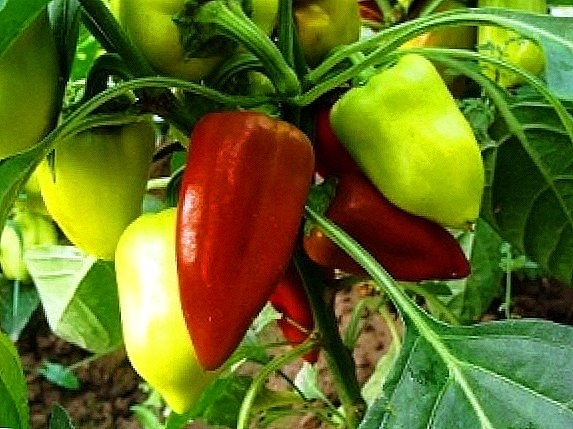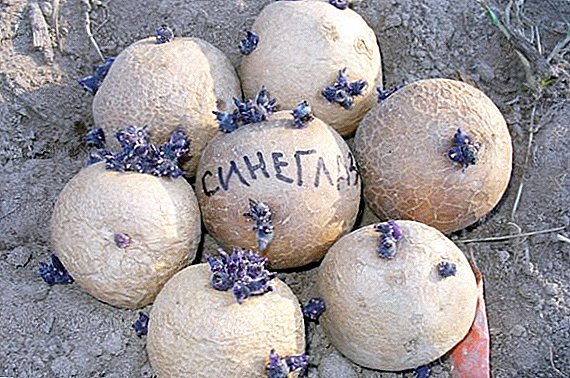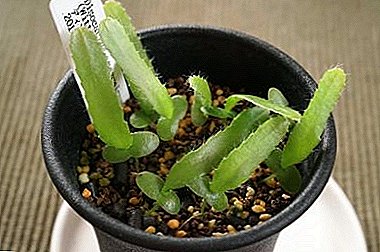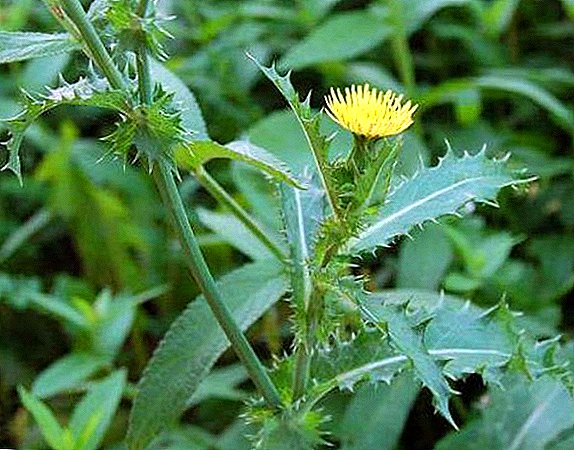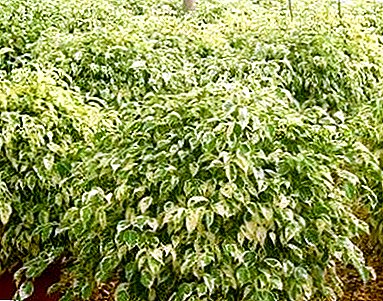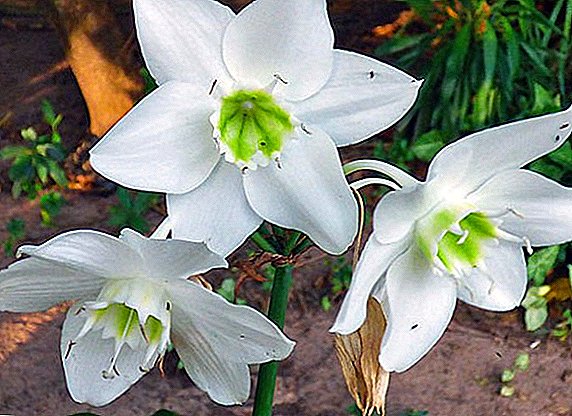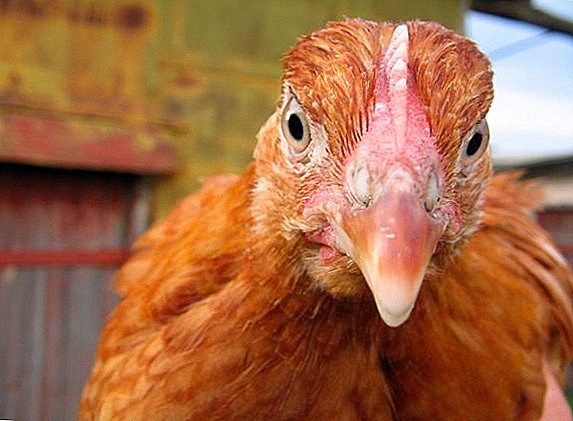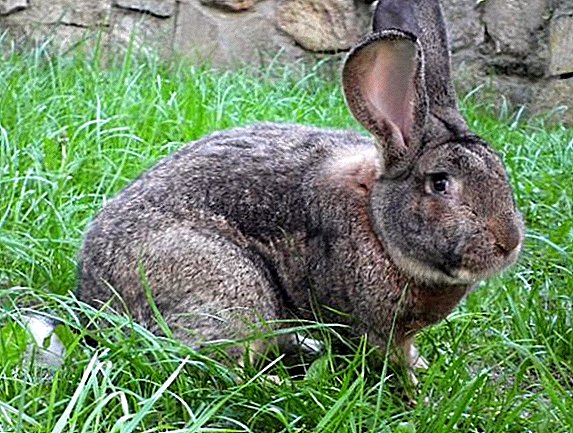 Flandre is considered a truly unique animal. This furry animal is capable of reaching sometimes gigantic sizes, which could not help but be liked by breeders around the world.
Flandre is considered a truly unique animal. This furry animal is capable of reaching sometimes gigantic sizes, which could not help but be liked by breeders around the world.
In addition, this variety of domestic animals is able to instantly gain mass, which automatically includes the animal in the list of ideal meat breeds.
However, not every farmer can create ideal conditions for such a pet, therefore, breeding giant rabbits often remains an unattainable dream. In this article we will get acquainted with the history of the appearance of this breed, as well as consider the main features of the successful breeding of rabbits.
Breed description
The Belgian giant has a truly unique appearance and history of origin. That is why now, at the attraction of several decades, interest in this species has not dried up.
But, like any other animal, the giant rabbit has its advantages, disadvantages and peculiarities, which determine the main conditions of housing and successful breeding of the breed.
Did you know? Rabbits have a unique structure of the eyeball, which gives them the opportunity to observe what is happening behind them, without turning their heads.
Historical roots
Today, this type of rabbit is one of the most mysterious and unsolved animals. And this is not by chance, since there is no single reliable information about the history of the beast.
Instead, modern breeders are aware of several hypotheses about the pedigree of this rabbit:
- the animal is the direct heir of the Patagonian rabbits, which were brought to Europe from Argentina in the XVI-XVII centuries;
- Flandres are considered descendants of huge Flemish rabbits bred in the 16th century by Flanders rabbit breeders;
- The breed belongs to one of the branches of hybrids of large Patagonian rabbits of the Argentinean line and large Flemish.

External parameters
Today, many professional breeding schools have brought a huge number of various flandrov. But no matter how skillfully the breeding of a new breed was carried out, the true Belgian giant does not lose its characteristic features.
Check out the list of the most popular giant rabbits.
The external parameters of the standard representative of the breed are as follows:
- average body weight - from 5-7 to 10 kg;
- maximum body weight is about 25 kg;
- body shape - slightly elongated, with well developed muscles;
- average body length - about 65-70 cm;
- chest girth - 35-40 cm;
- head is large, rounded, with wide cheeks and large, dense, protruding ears;
- type of coat - thick, thick and high;
- coat height - 3-4 cm;
- coat color — yellow-gray, dark gray, iron-gray, gray-hare;
- puberty - comes in 8-9 months after birth;
- the average number of cubs in a litter is 6-8;
- the maximum number of cubs in a litter is about 16;
- a special sign - the color of the coat must match the color of the claws.

Character
The Belgian giant has a calm and peaceful nature, which makes it almost an ideal pet. The rabbit is not conflict and gets on well with the relatives, as well as with other pets.
That is why many livestock breeders, except for household needs, quite often grow this rabbit as a pet. A distinctive feature of this furry animal is a special friendliness to the person. Even during periods of active breeding, this breed is often not characterized by sudden mood swings or aggression.
The cubs of this species differ in their full confidence in humans, which is why a small fluffy friendly rabbit often becomes an ideal pet for children. In addition, do not forget about the high mental abilities flandra.
Individuals of the breed are able to memorize simple commands, their master and family members, and in some cases the rabbit can easily compete in quick wits even with dogs. 
Advantages and disadvantages
The main advantages that clearly distinguish the Belgian giant from their relatives:
- the ability to rapidly gain weight and body size;
- thick, durable, but rather soft wool;
- good health;
- high productivity;
- increased breeding capacity;
- gentle and friendly nature;
- universality (the animal can be grown up both for the economic purposes, and as a pet).
Did you know? The wild ancestors of modern domestic rabbits were tamed by man on the territory of modern Asia as early as 2500-1800. BC erThe main disadvantages of the Belgian giant breed:
- low industrial value of the skin (as a result of a thin down layer);
- frequent congenital genetic defects of the limbs;
- frequent congenital abnormalities of the gastrointestinal tract, requiring constant treatment;
- quite low ratio between the total weight and the amount of pure meat;
- the rabbit is poorly adapted to growing in a cold northern climate;
- excessive gluttony, which reduces the profitability of industrial breeding.

Maintenance and care
Despite the fact that often rabbits are not difficult to breed, to grow flandra is not so easy. For a successful and prosperous growth and development, this furry animal requires special conditions, including not only perfect cleanliness in the cage, but also observance of the correct temperature and the necessary microclimate.
Only in this case, rabbit breeding will become not only interesting, but also quite profitable occupation.
Selection and arrangement of cells
Arrangement of a comfortable and high-quality cage is one of the main requirements to ensure the right conditions for the maintenance of Flandre. The animal belongs to the habitat quite capriciously, so you have to work hard.
It is best to keep this animal in spacious, specially prepared premises, giving the animal the opportunity to move freely.
Read more about how to choose a cage for rabbits and how to make it yourself.
However, such conditions are possible only in the case of mass cultivation of a fluffy beast in large farms, therefore, often with the arrangement of the cell, many are repelled from the recommended minimum standards of free space.  For an average adult male, the cage should not be less than 0.38 cubic meters. (1.1 mx 0.7m x 0.5m). In the case of keeping a healthy adult female, she should provide more free space.
For an average adult male, the cage should not be less than 0.38 cubic meters. (1.1 mx 0.7m x 0.5m). In the case of keeping a healthy adult female, she should provide more free space.
This is necessary in order not to cause cramping during the birth of offspring, since females in conditions of excessively tight space often resort to killing their own babies, therefore the minimum cage size for females at childbearing age should not be less than 0.9 cubic meters. (1.7 mx 1.1m x 0.5m).
The bottom of the cage must be laid with natural litter, not less than 7-10 cm thick. Straw is best for this purpose, but if it is not available, special hygienic mixtures for rabbits and large rodents can be used as litter.
A good and dense litter is imperative when breeding an animal, as it helps to achieve an optimal sanitary condition in the cage.
Important! The bottom of the cage must necessarily be covered with a smooth monolithic material (plywood, board, etc.), otherwise excessive bulges in the floor can cause injury to the paws and their further inflammation.
For a comfortable stay of an animal in a cage, it is imperative to provide a quality litter, as well as the presence of a drinker and a feeder. The feeder is best made from natural materials, as the rabbit can refuse to accept food from plastic containers.
Video: how to choose a cage for rabbits Depending on the type of food, you should choose the optimal type of such a device:
- a manger for grass and hay;
- bunker - for the loose or granulated forage;
- pan - for bulk or pelleted feed;
- gutter - for concentrated feed and root crops.
Drinkers exist automatic, semi-automatic and pan. The best option is the modern automatic or semi-automatic model with a portion of the water supply. Cup drinkers for rabbits are not recommended. They often fall remnants of food and feces, which threatens severe disorders for the gentle digestive system of animals.
We recommend to read about how to make a drinking bowl and feeder for rabbits.
It should also take care of the necessary microclimate for the animal. Flandre does not tolerate excessive freezing and moisture, so the animal must provide a dry and warm room. The optimal temperature for a rabbit is the average daily maximum of +20 ° C, however, seasonal decreases to +5 ° C are not terrible for him.
Pay attention that the cell is not subjected to excessive overheating in direct sunlight, which is also detrimental to the health of the animal, as well as prolonged cold. A place with a cage must be well ventilated, and direct drafts should be avoided. 
Care rules
A prerequisite for keeping an animal is to ensure an optimal sanitary condition in the cage. For this purpose, conduct periodic cleaning and disinfection.
The procedure is carried out as often as possible, but not less than 1-2 times a week in winter and at least 2 times a week in the summer season. To do this, you need to create a special schedule of sanitary cleaning, but it is best to do this as the cell becomes contaminated.
Important! It is not worth neglecting periodic cleaning in the rabbiter; otherwise, an excess of moisture and feces in the cage will become an ideal environment for the development of an infectious lesion of an animal with coccidiosis.
Cleaning rabbitrel includes the following steps:
- complete replacement of dirty litter;
- cleaning the feeders and drinkers with soap solutions from bacterial plaque;
- removal of large contaminants;
- cleaning the walls, floor and ceiling of the cell using cleaning soap solutions;
- drying the cells in a natural way.
 As working solutions often use:
As working solutions often use:- 5% solution of alcoholic iodine infusion;
- 10% bleach solution;
- 2% solution of potassium permanganate;
- 40% formalin solution;
- Creolin solution (2 ml / 10 l).
Cell firing is performed using special burners or a blowtorch for several minutes. The movement of fire should be carried out smoothly, starting from one edge, gradually moving to the opposite. After the procedure, the cell must be washed with running water and dried thoroughly.
As a result, thorough disinfection makes it possible to destroy up to 95% of pathogenic bacteria and avoid the development of dangerous infections. Improving the hygiene in the rabbitry will be helped by daily water changes and the elimination of food residues, especially when using mixtures based on fresh fruits or vegetables.
Vaccinations
Preventive vaccination of each individual is one of the main conditions for ensuring good health of Flandres. Despite the high resistance of the organism to various infections, these rabbits should be inoculated in order to develop a stable immunity against myxomatosis, the causative agent of hemorrhagic infection and pasteurellosis.
Video: what vaccinations do rabbits The first inoculation of small rabbits is carried out at the age of 1.5 months against pasteurellosis, after which preventive revaccination from this disease is carried out annually, but not more than once a year. Vaccination against the causative agents of myxomatosis and hemorrhagic infection is seasonal.
Preventive drugs are often administered in the middle of spring, before the activation of blood-sucking insects (mosquitoes, mosquitoes, etc.). The first vaccine is administered against myxomatosis, after which, 14 days later, vaccination against hemorrhagic infection is performed.
At the time of vaccination, each individual must necessarily reach the age of at least 1.5 months, otherwise the procedure is postponed until the next season.
Important! At the time of vaccination, rabbits must be healthy, in case of detection of any ailments in animals, the procedure is postponed until a more suitable time for this. Otherwise, vaccination can cause serious consequences for the body of Flandres, up to death.
Feeding rules
Rabbits of the Belgian giant breed are unpretentious to the diet and its composition, but in order to grow a really healthy animal with high-quality meat and skin, you must take care of the correct diet for it.  To do this, you first need to determine what kind of food will be useful for rabbits, and what food should definitely refuse. Only in this case, rabbit breeding will bring high profits.
To do this, you first need to determine what kind of food will be useful for rabbits, and what food should definitely refuse. Only in this case, rabbit breeding will bring high profits.
What can
Rabbits willingly regale almost any plant food and grain, but not all of them are notable for the necessary usefulness for their body.
That is why special food is suitable for feeding, which can be divided into several groups:
- juicy food: a variety of fruits and roots (carrots, cabbage, beets, turnips, zucchini, pumpkin, etc.);
- green food: all kinds of juicy field herbs and tops of fruit crops;
- coarse food: hay from cereals and legumes, straw, young branches of coniferous or deciduous trees;
- concentrates: soaked corn or bean groats, bran, mixed fodder, oilcake, etc .;
- vitamin supplements: dry or liquid mixtures with a high content of vitamins, minerals and other beneficial substances.
It will be useful for you to read about what they eat and how to feed rabbits in winter, which branches can be given to rabbits, what grass to feed rabbits, whether rabbits can eat nettle, corn, cereals and bread, and whether rabbits and mugs eat rabbits.
The perfect daily diet for rabbits should consist of:
- 2 pieces of succulent feed;
- 4 pieces of green fodder;
- 9 pieces of roughage.

However, in real conditions, the seasonality of many foods does not always make it possible to provide animals with a high-quality and rich diet, so you should definitely resort to the division of rabbit feeding into autumn-winter and spring-summer.
In the warm period of the year, mixtures of fresh grasses, juicy fruits and root crops become the basis for feeding the rabbits, which are additionally supported by a small amount of roughage and concentrates (no more than 10-20% of the total mass).
Did you know? Unlike current opinion, rabbits are not rodents, they represent a separate group of Leporidae, related to wild hares.
Starting from the second half of the autumn, rabbits are gradually transferred to the winter food:
- Juicy feed and grass should be limited, and instead of them to enter into the food a large number of roughage and concentrates (about 50-60% of the total mass). Thus, juicy food becomes only an additional bait, helping to avoid vitamin deficiencies and problems in the bowels.
- In addition, be sure that rabbits need to be provided with all sorts of vitamin and mineral supplements: bone meal, bone ash, chalk, table salt (for little rabbits), artificial vitamin premixes. They provide an opportunity to maintain the immunity of animals at a decent level and provide their body with the necessary amount of phosphorus and calcium.

Basic rules for feeding rabbits:
- food should be given in portions;
- the number of meals should not exceed 2 (in the morning and in the evening);
- feeding should be carried out strictly at the same time;
- it is not recommended to give fresh cut grass to rabbits, green feed should be slightly dried naturally;
- large fruits and roots should be carefully washed and chopped into small pieces;
- Fresh cabbage must be enriched with hay, it will protect animals from all sorts of disorders of the gastrointestinal tract;
- as food they use exclusively high-quality food, rotten and moldy food is dangerous for animals.
Read more about what you can not feed the rabbits.
What can not feed
It is strongly recommended not to feed flandra:
- potato tops;
- branches of elderberry and stone trees;
- such herbs as: aronica, belladonna, henbane, hemlock, cornflower, foxglove, hellebore, sable, celandine, raven eye, lily of the valley, St. John's wort, horsetail;
- feeds subjected to prolonged freezing.

Rearing
Sexual maturity in rabbits comes on the 8-9th month of life, from this point on, the animals are capable of giving birth to a healthy and full-bodied litter. Breeding in rabbits often occurs without reference to a specific period, so young offspring can be obtained throughout the year.
The number of offspring per year depends solely on the female and her natural need for mating. The case of males and females occurs over a period of 3-4 days, after which the female is ready to re-mate in 7-10 days.
The main signs of female readiness for mating:
- swelling and redness of the genitals;
- severe loss of appetite;
- продолжительная нервозность и беспокойство.
It will be interesting for you to read about when the rabbit can be allowed on the mating, how long it lasts and how to determine the rabbit suckering, when it is possible to set the rabbit away from the rabbit and how to determine the sex of the rabbit.
The case is carried out in a specially prepared large cell, devoid of unnecessary objects or other objects obstructing the process. The process is often carried out in two stages. In the first case, the male mates with the female twice, after which the individuals are seated in separate cells.
The second stage occurs 7-10 days after the first, at which time the test is carried out to achieve maximum process efficiency. A distinct sign of the rabbit's pregnancy is its sharp aggression towards the male, therefore, in the event of the manifestation of this trait, it is not recommended to carry out the control mating.  Cultural breeds of rabbits are often not able to independently create all the necessary conditions for the successful birth of offspring, so it is imperative that you take care of arranging the nest.
Cultural breeds of rabbits are often not able to independently create all the necessary conditions for the successful birth of offspring, so it is imperative that you take care of arranging the nest.
To this end, a so-called “mother liquor” is additionally created in the cell, which is a small insulated box with a hole, the bottom of which is carpeted with soft bedding of grass or straw. It is in it that the pregnant female will give birth to offspring, which in a few weeks will be able to actively move around the cage.
Did you know? The female rabbits are characterized by a split of the uterus, thanks to this particular organ, it is capable of simultaneously bearing two litters conceived from different males, which is a unique ability for mammals.
The duration of pregnancy is often no more than 30 days. At this time, the rabbit needs to create optimal conditions for the safe development of cubs in the womb.
First of all, the rabbit needs comfort, for this you need:
- provide twilight, diffused light, silence;
- remove other rabbits and other large animals;
- eliminate all sources of sharp and unpleasant odors (alcohol, tobacco, perfume, etc.);
- provide the rabbit with enough food and fresh drinking water.

Care for little baby rabbits is:
- Newborn rabbits do not require special human attention, as the rabbit is able to independently provide the offspring with the necessary care. However, 1-2 days after the birth of the litter, it is necessary to examine each cub for the presence of any pathologies. To do this, gently lure the female from the nest or temporarily transplant it into another cage.
- During the first 14–20 days, preventive examinations of the litter are carried out daily, and it is necessary to change the litter in the nest; otherwise, the offspring may become ill and die.
- During the first two weeks, rabbits are fed exclusively on breast milk, so during this period the rabbits need to provide enhanced vitamin nutrition from greens and vegetables, otherwise the mother can easily destroy some of the offspring.
- Starting from the 14th day, it is imperative to equip the feeder with fresh, finely shredded vegetables as a top dressing for rabbits near the nest. Approximately in 20-25 days the offspring is ready to eat more solid food, therefore it is necessary to pour high-protein feeds (bran, etc.) into the feeding trough.
- After 1-1.5 months, the rabbit completely stops lactation, after which the rabbits are transplanted into separate cages, otherwise the offspring may suffer from the mother in the process of fighting for free space.
Learn how and what to feed a nursing rabbit after a roundabout, as well as how to feed the rabbits without a rabbit.
Also during the period of feeding with milk, you should not forget about the care of the rabbit. Her body during this period requires high-quality nutritious food, so the rabbit food must be supplied with additional vitamins, minerals, proteins and other important substances.
Video: care for newborn baby rabbits For these purposes, her diet is enriched with a double portion of forage grasses, vegetables, and various premixes. The Belgian giant is a modern, highly productive breed of domestic rabbit, which boasts record-breaking products and high-quality fur.
That is why this animal has been actively used by breeders throughout the world for several centuries. But in order for rabbit breeding to become not only successful, but also profitable, it is necessary to strictly observe all the basic recommendations on breeding and growing the breed, regardless of the size of the farm.
Reviews from the network




